Sensory swimming provides unique benefits for children with autism through water’s natural pressure, which calms overstimulation and reduces anxiety. You’ll notice improved sensory regulation, stronger motor skills, and enhanced social interactions as your child enjoys the supportive aquatic environment. Water therapy offers structured routines that build confidence while developing transferable skills for everyday life. The pool’s supportive sensory experience creates opportunities for family bonding that extend far beyond the water’s edge.
The Sensory Magic of Water Pressure for Calming Overstimulation
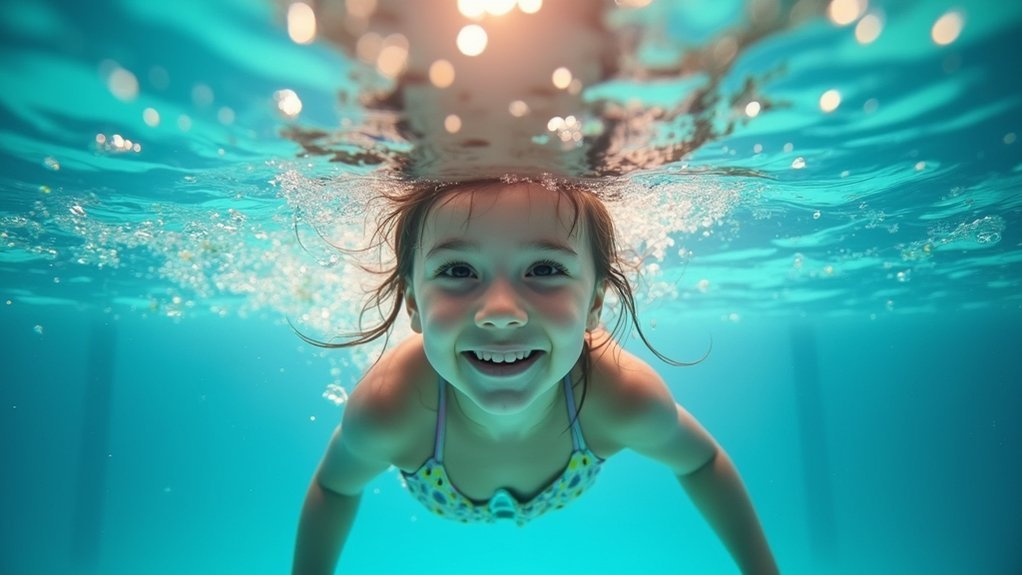
When children with autism step into water, they enter a uniquely therapeutic environment that offers relief often unattainable elsewhere. The hydrostatic pressure of water acts as a natural form of deep pressure stimulation, delivering uniform sensory input across the body—something weighted blankets can’t replicate.
This consistent pressure helps regulate sensory experiences, reducing anxiety and overstimulation. You’ll often notice a decrease in stimming behaviors as the water’s soothing embrace helps modulate sensory input. Water exerts 30 times more deep pressure than air, making aquatic environments exceptionally effective for sensory regulation.
The feeling of weightlessness combined with pressure creates a paradoxical calming effect that’s particularly beneficial for autism. Warm water enhances these benefits by creating comfortable conditions for sensory processing.
The sensory contrast of buoyancy and gentle pressure in warm water creates a uniquely calming sanctuary for autistic children.
Over time, this therapeutic pressure improves self-regulation skills and helps children maintain focus, creating lasting effects that extend beyond pool time.
Building Motor Skills Through Aquatic Resistance
Unlike traditional therapy environments, water provides unique advantages for children with autism to develop essential motor skills.
The natural resistance of water creates opportunities for your child to strengthen muscles while performing movements with reduced impact, making challenging land-based activities more accessible.
When your child moves through water, they’re working against gentle, consistent resistance that builds both fine and gross motor capabilities. This resistance naturally improves coordination, balance, and body awareness—skills that often need extra support in children with ASD.
The Halliwick method and other structured aquatic approaches offer targeted exercises disguised as fun activities.
You’ll likely notice improvements in your child’s posture, core strength, and overall motor competence, benefits that extend beyond the pool into daily functional movements and independence.
The hydrostatic pressure surrounding your child’s body during water therapy can significantly help with sensory regulation and reduce anxiety commonly experienced by those with autism.
Social Connection in the Pool: Breaking Communication Barriers

The water environment that strengthens your child’s motor skills also creates a remarkable space for social development.
In smaller, sensory-friendly classes, instructors trained in autism support can give your child personalized attention while encouraging meaningful interactions.
Water’s natural calming properties reduce sensory overload, helping your child focus on social engagement rather than environmental stressors.
You’ll notice swimming enables non-verbal communication through gestures and body movement, offering alternative expression channels when words don’t come easily.
Structured aquatic activities promote parallel play, allowing your child to engage socially without direct interaction pressure.
The shared experiences in water foster a sense of belonging, building friendships through common goals and achievements.
Swimming together builds more than skills—it creates community through shared aquatic victories and connections.
These pool-based social skills often generalize to improved communication in everyday situations.
Participating in designated sensory-friendly swim hours can dramatically improve the quality of social interactions by creating a less overwhelming environment for your child.
Confidence Building Through Swimming Milestones
Milestones in swimming become powerful confidence builders for children with autism. As your child masters each new skill—from floating to freestyle—they develop a sense of accomplishment that reinforces positive self-image and belief in their capabilities.
Swimming’s structured progression offers clear achievements that translate into greater self-esteem affecting academics and social interactions. The water safety awareness gained during swimming lessons is potentially life-saving for children with autism who may be drawn to water without understanding the dangers. When your child completes swimming lessons, they experience pride that encourages further personal growth and resilience.
The water environment uniquely supports motor skill development through buoyancy and resistance, improving coordination and balance without risk of injury. These physical improvements boost confidence in daily activities beyond the pool.
Group lessons also create opportunities for social engagement, helping your child connect with peers while building concentration skills and independence—all contributing to a stronger sense of self-efficacy.
Creating Structure: How Water Therapy Promotes Routine
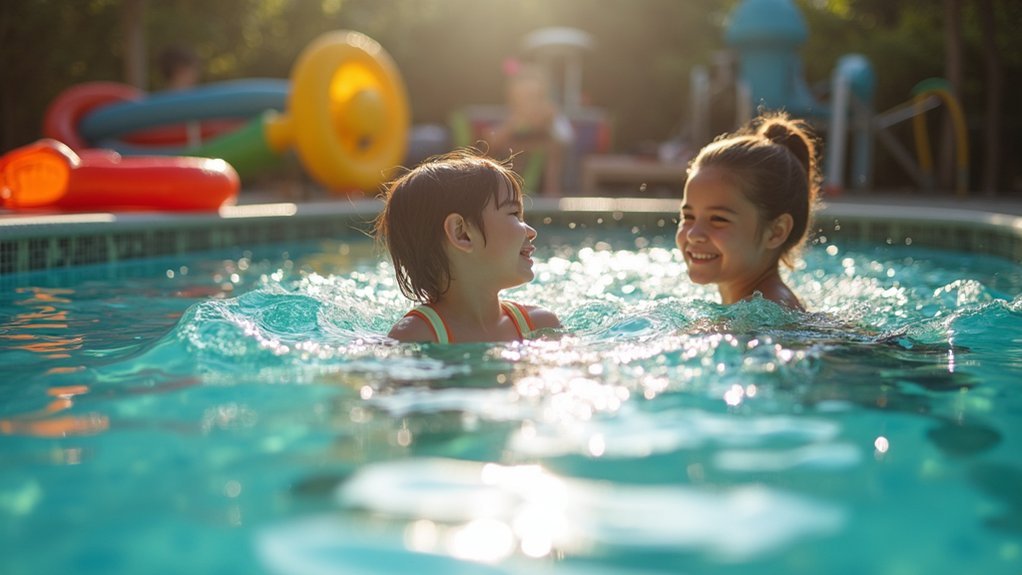
Water therapy creates a predictable environment for your child with autism through its consistent sensory experiences and physical boundaries.
You’ll notice how structured swimming sessions follow reliable frameworks with clear beginnings, shifts, and conclusions that mirror daily routines.
Visual swimming schedules, showing step-by-step progressions from changing clothes to specific water activities, reinforce time management skills and reduce anxiety about what comes next.
The structured water environment helps teach children with autism crucial water safety skills, which is especially important considering drowning is the leading cause of death for this population.
Predictable Aquatic Environments
For children with autism spectrum disorder, predictable aquatic environments offer a therapeutic sanctuary where clear boundaries and consistent routines foster security and growth.
You’ll notice how the defined space of a pool creates natural boundaries that help your child understand expectations and limits.
The controlled sensory stimulation in water therapy reduces anxiety while promoting emotional regulation.
Your child can master repetitive aquatic exercises, enhancing both physical abilities and cognitive development.
The hydrostatic pressure of water provides a soothing effect that helps alleviate sensory overload.
With consistent therapists and repeated activities, your child can better anticipate what’s coming next, increasing their engagement and confidence.
The Halliwick method provides a structured four-phase approach that gradually builds water confidence and movement control for children with autism.
The predictable nature of these sessions minimizes stress and creates an ideal environment where therapeutic goals become more achievable, supporting continuous developmental progress.
Consistent Session Frameworks
Establishing consistent session frameworks builds upon the predictable environment by adding temporal structure to your child’s aquatic therapy experience. When your child attends sessions at regular intervals—typically twice weekly—they develop familiarity with the routine, reducing anxiety and creating comfort in the aquatic setting.
Each structured session reinforces skills through beneficial repetition, helping your child master swimming techniques while improving their ability to follow instructions and take turns. This consistency supports cognitive development as they learn to anticipate activities and changes within the session.
You’ll notice these frameworks integrate multisensory experiences in a controlled manner, allowing your child to process water’s unique sensory properties without overwhelm. Working with trained swim teachers ensures a supportive learning environment tailored to your child’s unique sensory needs.
Over time, this structured approach not only enhances aquatic skills but also builds valuable social interactions and self-regulation abilities that transfer beyond the pool environment.
Visual Swimming Schedules
Visual swimming schedules serve as powerful organizational tools that transform the aquatic learning experience for children with autism. These visual aids help your child understand the sequence of activities, making shifts smoother and reducing anxiety through predictability.
You’ll notice your child becoming more independent as they learn to anticipate what comes next. The structured routine creates security in the pool environment, allowing them to focus on skill development rather than worrying about unexpected changes.
These schedules also boost communication skills—many children increase their vocalizations when interacting with visual supports during lessons. The consistency provided by these tools reinforces skill retention while promoting behavioral regulation. Creating a sensory-friendly environment with appropriate water temperature and lighting adjustments complements these visual schedules for maximum comfort and engagement.
For social development, visual schedules detail group activities, encouraging teamwork and peer connections that might otherwise be challenging for your child.
Adapting Swim Environments for Sensory Needs
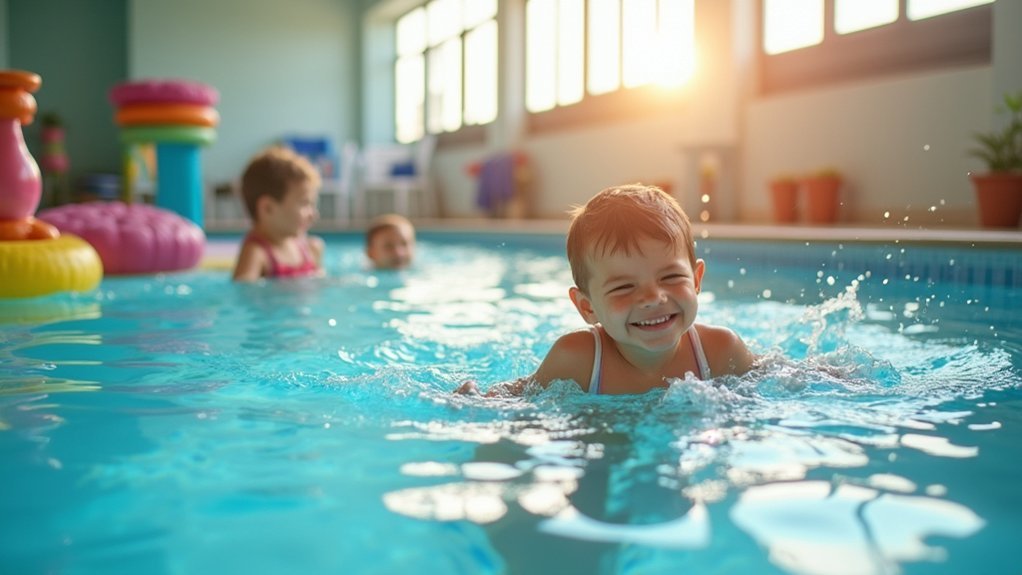
Creating an autism-friendly swim environment requires thoughtful adaptation of physical spaces to accommodate diverse sensory needs. Start by reducing noise levels—silence background music, limit whistle use to emergencies, and manage crowd size to minimize echoing sounds that can trigger sensory overload.
Consider establishing designated quiet rooms where swimmers can retreat when feeling overwhelmed. Water provides a calming experience that can help reduce anxiety for children with ASD who might become overstimulated in typical swim environments. Soften lighting throughout facilities to reduce visual stimulation, and remove potentially distressing equipment like wave machines during sensory sessions.
Select appropriate swim gear and toys that provide comfort and security. Pool noodles and flutterboards can help ease children into independent swimming.
When choosing equipment, prioritize items that allow for repetitive, calming movements rather than those producing additional noise or stimulation.
Family Bonding Through Shared Aquatic Experiences
Sharing water play moments with your autistic child creates unique opportunities for your entire family to connect on a sensory level.
You’ll notice trust building naturally as you splash, float, and explore the calming aquatic environment together.
These shared experiences become treasured memories that strengthen family bonds while supporting your child’s development in a joyful, pressure-free setting.
Many families report significantly increased comfort and ease for their children during water activities, making aquatic environments ideal for meaningful connections.
Shared Water Play Moments
Water transforms ordinary family interactions into meaningful bonding experiences for children with autism. When you engage in water activities together, you’re creating non-electronic leisure opportunities that everyone can enjoy, including siblings.
These shared moments foster emotional connections while children express themselves freely in the calming aquatic environment. You’ll notice your child communicating more—verbally describing sensations or following instructions in this low-pressure setting.
Water play sparks creativity too. Watch as your child explores with water-safe toys, pours water between containers, or experiments with bubbles and sponges. These activities naturally enhance fine motor skills and problem-solving abilities. The consistent, gentle water pressure helps reduce anxiety and provides a uniquely soothing sensory experience for children with autism.
The inclusive nature of water play creates a space where the whole family can participate, strengthening relationships and creating lasting memories while supporting your child’s development in a fun, engaging way.
Building Trust Together
When families share aquatic experiences, trust blossoms naturally between you and your child with autism. The water’s calming properties create a soothing sensory environment where anxiety diminishes, allowing for genuine connection.
You’ll notice how the controlled sensory stimulation helps your child regulate emotions while experiencing joy. These moments of mutual relaxation build a foundation of trust that extends beyond the pool. Your child learns they’re safe with you in this new environment.
Water activities provide perfect opportunities for inclusive play where siblings can participate equally, strengthening family bonds. Always ensuring your child remains within arm’s reach near water creates a secure foundation for these bonding experiences.
As you adapt activities to meet your child’s specific sensory needs, you’re creating a safe space for emotional expression and connection. The shared experience of overcoming challenges together—whether it’s floating for the first time or trying a new water game—deepens your relationship in meaningful ways.
Creating Lasting Memories
The joy of splashing together creates lasting family memories that extend far beyond the pool’s edge. When you share water activities with your child with autism, you’re building powerful emotional connections in an environment that naturally calms and soothes sensory systems.
Swimming and water play offer an inclusive alternative to sedentary activities, encouraging everyone to participate regardless of ability level. The buoyancy of water supports movement for children with motor challenges, making these experiences truly accessible for the whole family.
Take advantage of this shared leisure time to engage in imaginative play with floating toys and sensory equipment. These moments of laughter and discovery strengthen family bonds while supporting developmental milestones.
The shared experience of overcoming challenges and celebrating progress in the water becomes part of your family’s unique story.
From Pool to Daily Life: Transferable Skills From Water Therapy
Beyond the splashing and swimming techniques, aquatic therapy offers children with autism a wealth of skills that seamlessly adapt into everyday situations.
The pool becomes a training ground where ripples of progress extend far beyond the water’s edge.
The focus and attention developed during water activities translate directly to classroom settings, where children demonstrate improved task concentration and reduced hyperactivity.
You’ll notice your child’s enhanced impulse control extends to daily routines, making adjustments smoother.
The oral motor skills strengthened during aquatic exercises often support better speech development, while newfound physical confidence encourages trying new activities outside the pool.
The self-regulation techniques practiced in water’s calming environment help children manage emotions in potentially overwhelming situations.
The hydrostatic pressure from water therapy provides continuous sensory input that many children with autism crave, helping them remain regulated even after leaving the pool.
As your child masters maneuvering the sensory-rich pool environment, they’re simultaneously building a toolkit for success in school, home, and community settings.
Selecting the Right Adaptive Swimming Equipment for Success
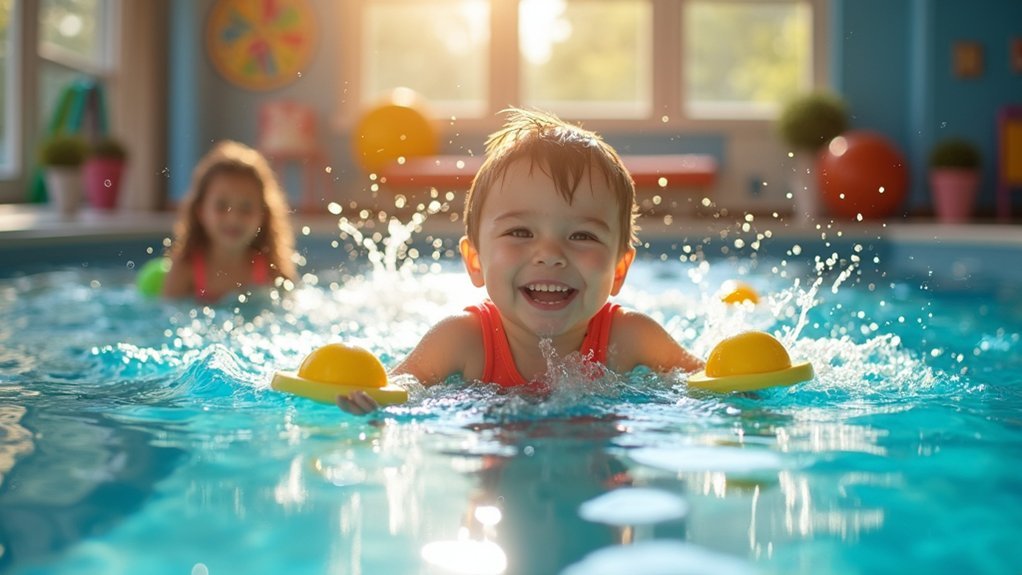
Choosing the right adaptive swimming equipment for your child with autism starts with essential safety gear that meets Coast Guard approval standards.
Sensory-friendly flotation devices like Frogglez goggles and specialized swim vests can reduce anxiety while providing necessary support during water activities.
You’ll also want to incorporate skill-building aquatic tools such as pool noodles and flutterboards that can be customized to your child’s specific sensory needs and learning pace.
When selecting equipment, remember to familiarize swimmers with lifejackets and rescue tubes so they understand their purpose during regular practice sessions.
Safety Gear Essentials
Selecting appropriate safety equipment stands as a cornerstone of successful adaptive swimming programs for children with autism. When choosing flotation devices, prioritize U.S. Coast Guard-approved options that provide stability and reassurance both for your child and yourself as a caregiver.
Work with adapted aquatic instructors to find gear that matches your child’s specific body type, strength, and movement style. The right equipment enhances independence while maintaining safety. Since children with autism are three times likelier to experience drowning incidents than their neurotypical peers, selecting proper safety gear is particularly critical.
- Personalized flotation devices that accommodate your child’s unique sensory needs
- Wearable safety devices like wristbands that alert supervisors if a swimmer moves outside safe areas
- Monitoring systems to track body and breath control for children with sensory-seeking behaviors
- Life jackets and rescue tubes to build fundamental water safety awareness
Sensory-Friendly Flotation Devices
The right sensory-friendly flotation device can transform a child’s aquatic experience from overwhelming to empowering.
When selecting equipment, assess your child’s sensory preferences and needs first.
Look for devices made with soft materials that provide comfortable tactile input while maintaining proper weight distribution. Adjustable buoyancy levels allow you to customize support as your child develops water confidence.
Many effective flotation aids feature colorful designs that engage visual attention without overwhelming sensory systems.
Consider equipment that allows freedom of movement while maintaining stability—this balance encourages exploration while building confidence.
The best devices often incorporate different textures and accessible features that promote independence.
Remember that involving your child in the selection process whenever possible guarantees the equipment meets their specific sensory profile, making water therapy both beneficial and enjoyable.
Properly designed flotation devices support proprioceptive development by providing resistance that enhances awareness of body position in the water.
Skill-Building Aquatic Tools
While every child with autism has unique sensory needs, appropriate skill-building aquatic tools fundamentally enhance their swimming experience and development.
Select equipment that gradually introduces new challenges while providing sensory comfort and safety support.
- Paddle boards and kickboards – Choose lightweight, textured options that improve balance while offering a secure grip for children with tactile sensitivities.
- Water-resistant communication cards – Use visual supports that function underwater to help maintain routines and expectations.
- Sensory-friendly resistance tools – Incorporate water weights and pull buoys with different textures to build strength without overwhelming sensory systems.
- Adjustable flotation devices – Invest in equipment that can be modified as your child’s skills progress, allowing for gradual independence in the water. Properly selected aquatic equipment creates a calming atmosphere through hydrostatic pressure, helping reduce anxiety and improve concentration during water therapy sessions.
Measuring Progress: Celebrating Small Victories in Aquatic Development
Measuring progress in aquatic therapy for children with autism requires both scientific precision and a compassionate eye for meaningful developments. Tools like the Water Orientation Test Alyn-2 (WOTA2) provide reliable assessments with an impressive 0.97 intraclass correlation coefficient, while Goal Attainment Scaling helps you establish personalized benchmarks.
You’ll notice improvements first in breath control skills, which typically advance more quickly than propulsion or pool-exiting abilities. Parents frequently report that their children experience improved sleep and appetite following regular swimming sessions.
When tracking your child’s development, celebrate each small victory—whether it’s holding breath underwater for three seconds or successfully floating independently.
Frequently Asked Questions
At What Age Should Children With Autism Begin Aquatic Therapy?
You can start aquatic therapy at any age, as there’s no specific limit. Early intervention brings benefits, helping your child develop water safety skills, sensory integration, and motor abilities more effectively.
How Do Swimming Programs Accommodate Children With Severe Water Phobias?
Swimming programs accommodate severe water phobias through gradual exposure, smaller classes, and trained staff. You’ll find they use positive reinforcement, individualized plans, and sensory-friendly environments to build your child’s comfort and confidence gradually.
Can Medication Interactions Affect Safety During Water Therapy Sessions?
Yes, medication interactions can considerably affect your safety during water therapy. You’ll face increased risks if you’re taking tranquilizers, sedatives, blood pressure medications, or narcotics, which can cause dizziness, thermoregulation issues, and unsteadiness.
What Qualifications Should Autism-Specialized Swim Instructors Have?
You’ll need swimming certification, autism-specific training like Autism Swim, and knowledge of neurodiversity. Allied health degrees, understanding of sensory needs, and positive behavior support approaches will strengthen your qualifications as an autism-specialized instructor.
Are Insurance Companies Covering Autism-Specific Aquatic Therapy Programs?
Coverage for autism-specific aquatic therapy varies by insurance plan. You’ll need to verify your policy details, as some cover it under occupational therapy benefits. Always get a medical professional’s recommendation for approval consideration.
In Summary
You’ll find water therapy offers more than just swimming skills for your child with autism—it’s a gateway to sensory regulation, motor development, and social growth. As you’ve seen the ripples of progress extend beyond the pool into daily life, remember that each splash represents a step forward. Trust in the process; water’s gentle embrace continues supporting your child’s journey long after you’ve dried off.

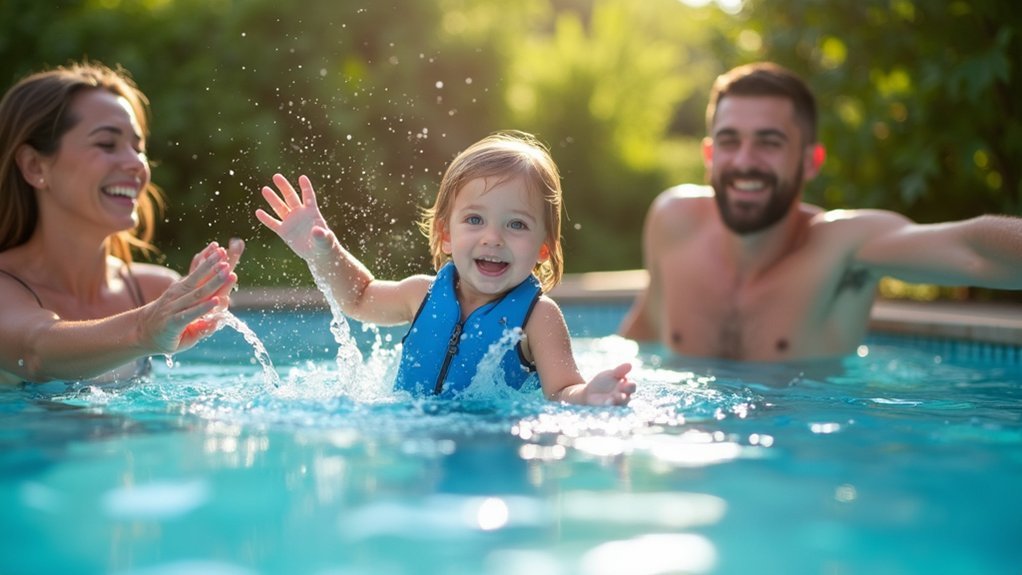



Leave a Reply